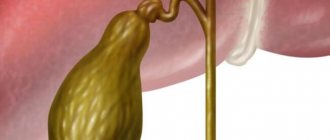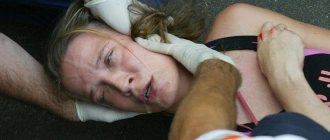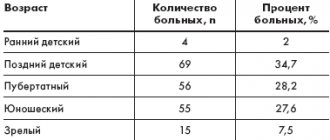Focal epilepsy is a type of epilepsy in which epileptic seizures are caused by a limited and clearly localized area of increased paroxysmal activity of the brain. Often it is of a secondary nature. It manifests itself as partial complex and simple epiparoxysms, the clinical picture of which depends on the location of the epileptogenic focus. Focal epilepsy is diagnosed based on clinical data, EEG and MRI results of the brain. Antiepileptic therapy and treatment of the causative pathology are carried out. According to indications, surgical removal of the area of epileptic activity is possible.
- Causes and pathogenesis of focal epilepsy
- Classification of focal epilepsy
- Symptoms of focal epilepsy Clinical features depending on the location of the epileptogenic focus
- Prognosis of focal epilepsy
Types of epilepsy
It is classified into primary generalized and partial seizures. In primary generalized
seizures, both hemispheres of the brain are involved. They are divided into tonic-clonic and absence seizures.
Tonic-clonic seizures
Symptoms of the tonic phase:
- convulsions, tense body, limbs bend;
- the jaw is clenched, the attack is preceded by a cry (due to muscle spasms);
- loss of consciousness.
The clonic phase is characterized by:
- copious secretion of saliva;
- there may be urinary incontinence;
- twitching of limbs for several minutes;
- after a few minutes return to consciousness.
After an attack, there may be confusion for a short time, the person is drowsy, and has difficulty perceiving what is happening around him. If a tonic-clonic seizure lasts longer, then emergency medical attention is needed.
Tonic seizures
There is a sudden overstrain of the muscles, the eyes roll back, and breathing is difficult due to the overstrain of the chest muscles. If the attack begins in a standing position, the patient may fall and be injured. The seizure is short-lived, less than 20 seconds. Tonic epilepsy usually involves damage to the brain.
Atonic attacks
Symptoms:
- loss of consciousness;
- attacks are short;
- sudden loss of muscle tone;
- fast recovery;
- absence of seizures;
- Children may throw their head back during an attack.
If a person is sitting or lying down, the attack may go unnoticed.
Clonic seizures
They are rare. Manifested by muscle spasms and repeated twitching.
Myoclonic spasms
The attack appears suddenly and may be short. In this case, involuntary movements of the whole body or arm, head occur. The patient may fall. But after the fall the attack ends. Such convulsions also appear in healthy people while falling asleep: they manifest themselves as shuddering of the body or limbs.
Absence
Absence seizures are classified as generalized seizures and most often occur in children under 14 years of age. They are not always noticeable. Manifests itself in very short blackouts. Absence is often confused with daydreaming or having your head in the clouds.
Main symptoms:
- the child looks intently at one point and blinks;
- walking aimlessly, cutting off sentences mid-sentence;
- eye rolling;
- lack of reaction.
This type of epilepsy may stop before puberty.
Diagnostics
The diagnosis of epilepsy is made based on history and symptoms. The epileptologist conducts a full neurological examination, assesses behavior, movements, thinking skills, memory and speech; asks to tell how the attacks go, what can provoke them, how the patient feels before and after the attack. If you have a video recording of the attack, be sure to show it to the doctor; if not, he will ask your loved ones to make it.
Laboratory tests are ordered to rule out or identify signs of infection, genetic disorders, and other conditions that may cause attacks.
An electroencephalogram (EEG) is ordered to check the electrical activity of the brain. This is a fairly indicative and common method for diagnosing epilepsy. Sometimes, to provoke epileptic activity, an EEG can be performed with functional tests: photostimulation, sleep deprivation, sleep, hyperventilation. CT and MRI are prescribed to visualize various brain structures and identify abnormalities such as cysts, tumors, hemorrhages, and blood flow disorders.
Accurate diagnosis of the type of epilepsy and provoking factors (triggers) helps to select effective treatment.
Partial or focal seizures
These are the most common manifestations of epilepsy.
They occur when cells are damaged in a certain area of one or the other hemisphere of the brain. Symptoms allow you to determine the source of damage. They are divided into simple, complex and secondary generalized. Simple partial seizures It may be a precursor to a complex partial seizure. Consciousness is not impaired. Patients report the condition as an aura. It is characterized by a state of euphoria, a feeling of unpleasant odors, unusual sounds, darkening of the eyes, anxiety, a feeling of fear, restlessness. Having learned to identify the aura, the patient is able to prevent and prevent complications.
Symptoms:
- convulsive movements;
- mental disorders;
- disorders of sound, taste, smell.
Complex partial seizures
Characteristic symptoms are a simple attack, but with impaired consciousness. “Automatic” behavior is noted: fiddling with clothes, buttons, wandering without purpose, a grimace may be distorted on the face, the jaw may perform chewing movements. They can become secondary generalized.
Secondary generalized seizures
Complex seizures with the spread of the epileptic discharge to both hemispheres of the brain. Sudden loss of consciousness, before this there may be a sensation of an aura, but not always. There may be convulsive muscle movements. In this case, the period of loss of consciousness can be very short and unnoticeable even for the patient himself.
Causes of epileptic seizures
Epilepsy is divided into several types
to quickly create a treatment plan.
Divided into symptomatic, idiopathic and cryptogenic epilepsy
. Cryptogenic epilepsy is considered unstudied. A thorough diagnosis may not reveal the causes of cryptogenic epilepsy. Changes in the brain may not show up even on electroencephalography. It is generally accepted that cryptogenic epilepsy is a severe disorder of the central nervous system. Progression is manifested by a decrease in mental abilities, deterioration of memory and concentration.
Symptomatic epilepsy is diagnosed quickly and accurately. Most often it is expressed in a defect (the presence of a tumor, hemorrhage or other conditions). Idiopathic epilepsy is inherited
, while the diagnosis may not show any changes in the hemispheres of the brain. The following factors can provoke the appearance of the disease:
• influence of drugs, alcohol and medications; • complications of labor and congenital diseases; • disorder in the vascular system; • Alzheimer's disease, multiple atherosclerosis; • infectious and parasitic diseases; • severe head injuries (craniocerebral); • accumulation of cerebrospinal fluid due to diseases; • consumption of gluten, celiac disease if you are allergic to these components; • vascular disorders.
Symptomatic epilepsy can occur as a result of developmental defects, infections, intoxications, strokes, as well as in the presence of a cyst or brain tumor. Alcohol and drugs can also influence the development of the disease. In idiopathic epilepsy, genetic provoking factors are identified during diagnosis. Most often, a person remembers attacks from early childhood, but does not remember what exactly happened. Children do not tell their parents about symptoms until they become obvious and alarming to them.
Nonconvulsive manifestations
These are the most difficult seizures to diagnose.
Can occur in children and adults. Symptoms can manifest themselves in the form of mental pathology - clouding of reason. This form responds very poorly to drug therapy. Symptoms:
- short-term attacks with “switching off” consciousness;
- change in facial expressions;
- vivid manifestations of pathological joy or negative emotions: rage, even suicide;
- delirium, visual hallucinations, confusion and nonsense of speech.
This form of the disease is the most dangerous, because it is often undiagnosed and untreated.
Localization of the lesion
Symptoms can inform the doctor about the location of the lesion.
Temporal lobe epilepsy most often manifests itself as a feeling of déjà vu. The cells of this part of the brain are responsible for memory, sound perception, and emotions. The patient may think that he hears music. Damage to this part of the brain is characterized by the experience of emotions - anxiety, fear, worry, joy, admiration.
Frontal lobe epilepsy has many different symptoms, depending on the part of the frontal lobe that is involved. The patient may experience many emotions, perform repetitive movements, chewing, and tongue movements.
Parietal epilepsy is rare. The parietal lobe of the brain is responsible for the sensitivity of the body. A person may feel warmth in the body, tingling, and a feeling that the body is being divided into parts. The brain distorts perception and a person misinterprets what is happening to him.
Occipital epilepsy is rare. With this type, visual hallucinations and loss of part of the field of vision occur. The eyes may move, and the person may experience severe headaches.
Effective therapy
Drug therapy
The doctor prescribes anticonvulsants; they suppress the occurrence of pathological impulses in the brain. Additionally, anticonvulsants and psychotropic drugs (hypnotics, antidepressants, tranquilizers) are prescribed. Psychotropic medications should be taken without violating the doses prescribed by the doctor. Because they may be triggers for attacks or side effects.
The disease can be controlled with drug therapy, and sometimes complete cure of the disease can be achieved.
Diagnosis of the disease
Only a neurologist can make an accurate diagnosis if any symptoms of the disease have been identified. Before making a diagnosis, you need to conduct a large number of examinations and compare the results. Anamnesis plays an important role in the search for a diagnosis. The doctor conducts an in-depth survey to determine the presence of other diseases and predispositions. The following types of examinations are primarily prescribed:
• CT scan; • conducting electroencephalography; • magnetic resonance imaging (MRI); • positron emission tomography.
The types of seizures, when they were first detected, as well as provoking factors are taken into account. After analyzing the obtained examination data and talking with the patient, a treatment plan is drawn up. These include both medications and non-drug procedures. With the inclusion of drugs in the treatment system, high efficiency can be achieved. If the patient adheres to the treatment plan, the frequency and duration of attacks can be reduced several times.
Electrical stimulation of the vagus nerve
This type of treatment is prescribed as an additional method of therapy.
In many countries it is an adjuvant treatment method. It reduces the number of partial seizures in children and adults. Therapy helps prevent the abnormal activity that leads to seizures.
An electrical pulse generator is used and inserted under the collarbone or under the skin near the armpit. The electrode is attached to the vagus nerve. This method allows to reduce the frequency of seizures in patients.
First aid
It is necessary to remove sharp, heavy objects and those that are dangerous for the patient and others.
It is advisable to find something soft to place under the patient’s head. Do not hold the patient by force - this will worsen the condition. You need to note for yourself the time the attack began; if it lasts more than 5 minutes, you need to call a medical ambulance. There is no need to unclench your jaws so as not to injure your tongue, teeth and oral mucosa due to muscle hypertonicity. It is necessary to fix the victim’s head between the legs, place clothes, a blanket, a pillow under it, or roll up the clothes. Tight clothing needs to be loosened. If there is excessive salivation or vomiting, then the head or the entire body must be turned to one side. The patient may experience spontaneous urination.
You should seek medical help if:
- traumatization;
- if the attack lasts more than 5 minutes or repeats without the person returning to consciousness;
- if the seizure happened for the first time;
- if an attack occurs in a pregnant woman, a child, or an elderly person.
After the attack ends, it is necessary to place the victim in a comfortable position, perhaps on his side. Check if the airways are clear. When a person begins to come to his senses and can already coordinate movements, it is advisable to help him and try to calm him down.
Usually, patients with epilepsy have a note with them with their contacts, phone numbers of relatives, and home address. Relatives need to be notified about what happened.
Treatment: how to go into remission?
Treatment of epilepsy primarily involves individual selection of medications.
When drawing up a treatment plan, the nature of the attacks is taken into account. To begin with, a small, insignificant dose is prescribed to analyze the body’s reaction and eliminate the factor of increased symptoms. Then the dose is increased until the final effect is achieved - long-term remission. The patient should not change the dosage or take breaks - this may adversely affect the results of treatment. If drug treatment is ineffective, surgical methods are prescribed. The format of surgical intervention depends on the lesion and its location. Possible forms of surgical intervention: • removal of tumors; • removal of the area of the brain in which the lesions appear; • cuts in the brain tissue, which help stop the progression of epilepsy; • dissection of the corpus callosum (in severe forms of the disease); • removal of half of the cerebral cortex (before the age of 13); • installation of a vagus nerve stimulator for a calming effect.
People diagnosed with epilepsy should adhere to a daily routine
.
It is critical for them to get enough sleep
(they wear dental protection while sleeping) and to walk outside every day.
Taking a bath is not recommended, only a quick shower. Physical activity is encouraged
. A person with epilepsy should have alert systems installed for family and friends. For example, a security system, an emergency call in case of a fall, or special medical applications on the phone. It is important to make the room where people are most often found safe. This is his home and work space. There should be no glass interior items, sharp corners, or publicly accessible electrical wiring in the room. It is not recommended to use kitchen appliances alone.








